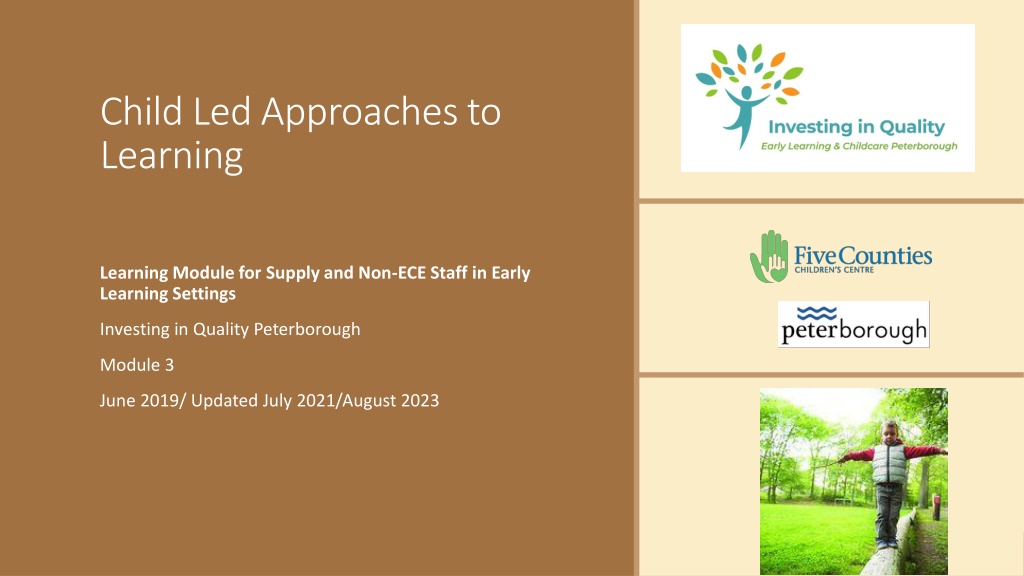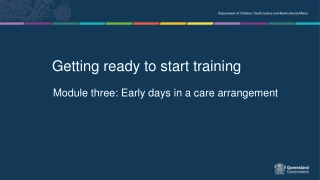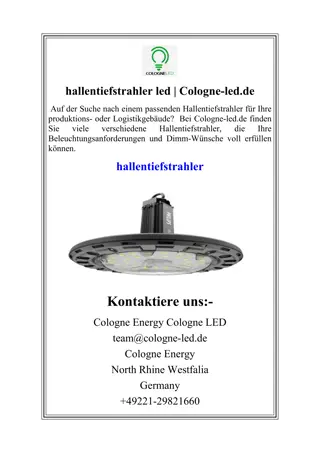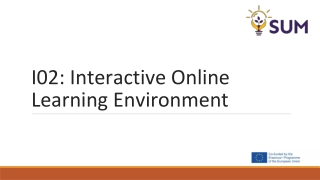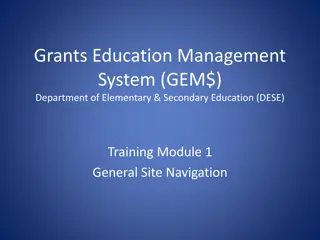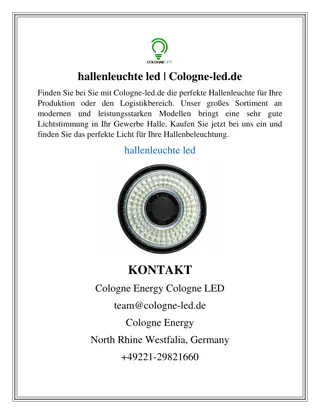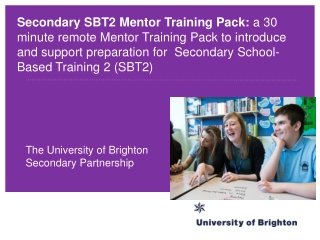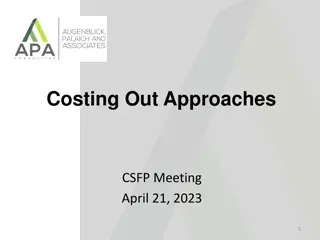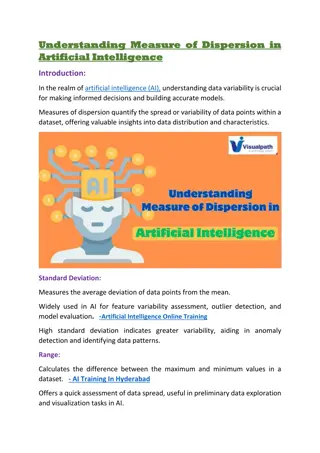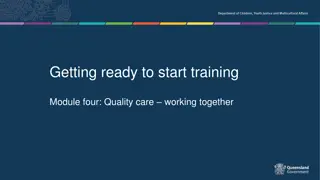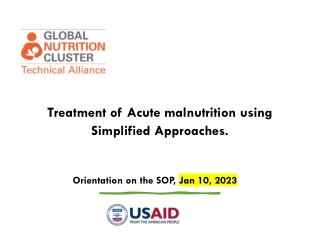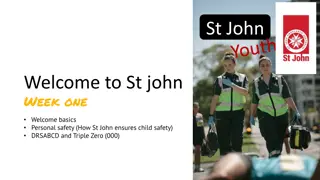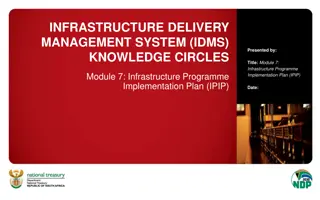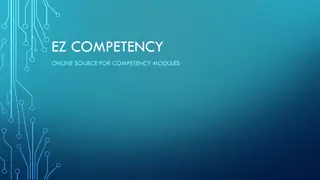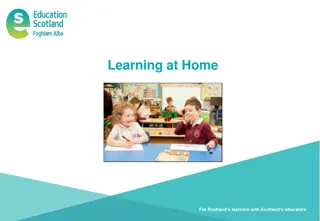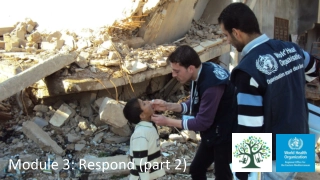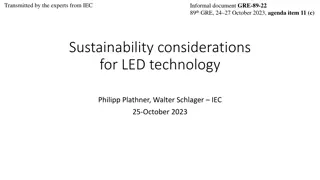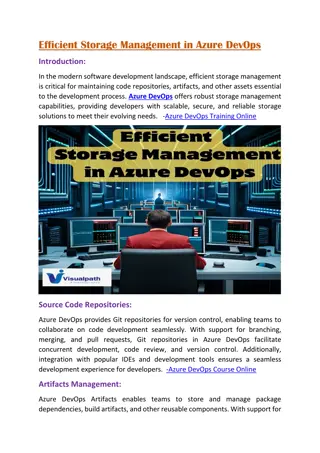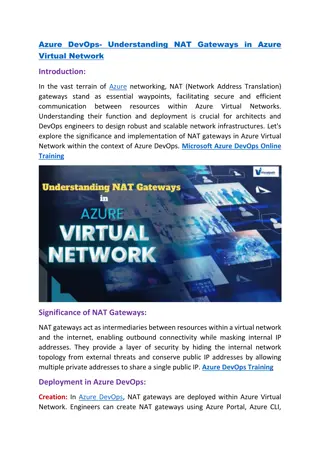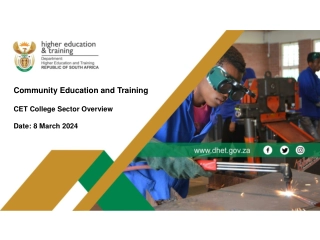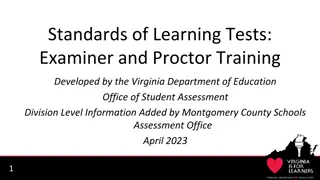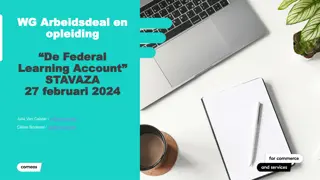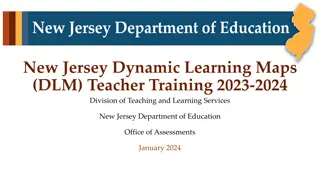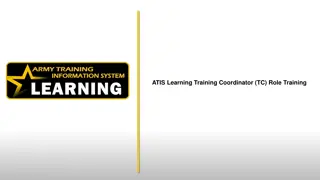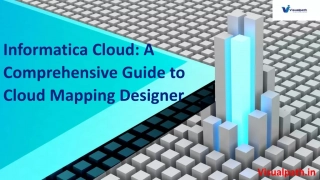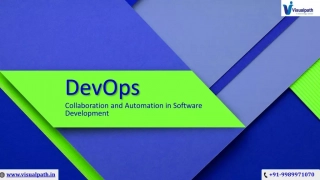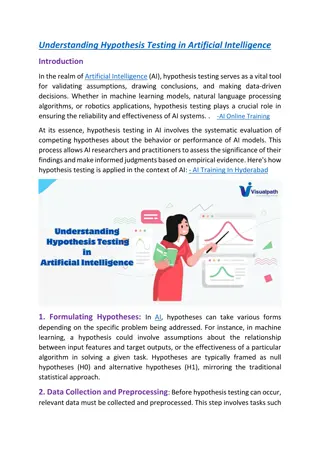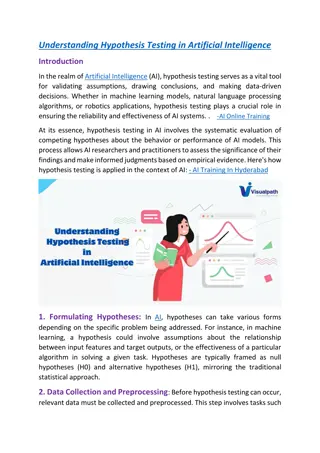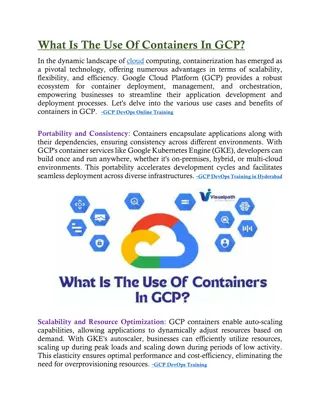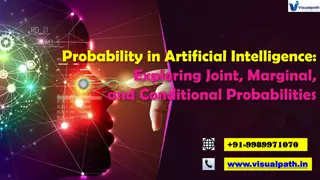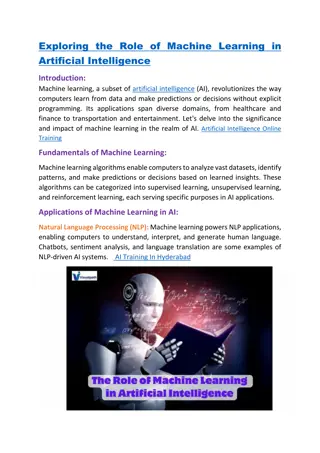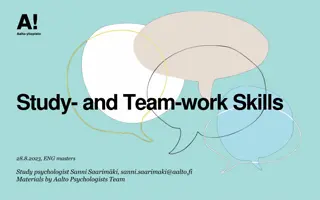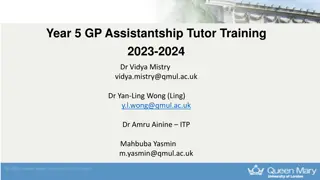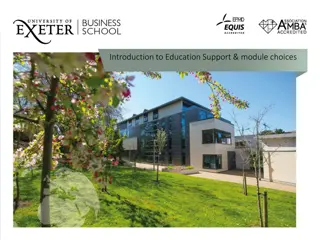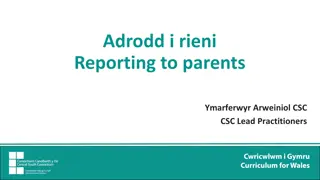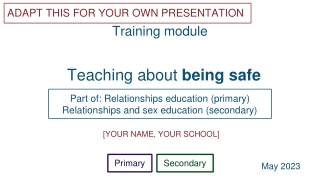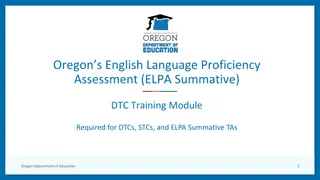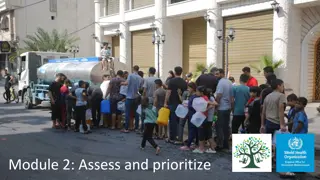Child-Led Approaches to Learning - Training Module Overview
In this training module series for supply and non-ECE staff in early learning settings, the emphasis is on child-led approaches to learning, exploring topics like how learning happens, responsive relationships, and child development. The objective is to enhance the skills of staff members and elevate the quality of early childhood education in Peterborough. The modules include engaging materials, reflections, and resources to encourage active participation in learning.
Child-Led Approaches to Learning - Training Module Overview
PowerPoint presentation about 'Child-Led Approaches to Learning - Training Module Overview'. This presentation describes the topic on In this training module series for supply and non-ECE staff in early learning settings, the emphasis is on child-led approaches to learning, exploring topics like how learning happens, responsive relationships, and child development. The objective is to enhance the skills of staff members and elevate the quality of early childhood education in Peterborough. The modules include engaging materials, reflections, and resources to encourage active participation in learning.. Download this presentation absolutely free.
Presentation Transcript
Child Led Approaches to Learning Learning Module for Supply and Non-ECE Staff in Early Learning Settings Investing in Quality Peterborough Module 3 June 2019/ Updated July 2021/August 2023
Purpose of these Training Modules This power-point presentation is part of a series of training modules for supply and non-ECE staff working in Early Learning and Care in Peterborough City and County. Training for these important staff has been identified as a priority for our Quality Initiative program, as 55% of our workforce does not have their Early Childhood Education designation. Along with Child Led Approaches to Learning, this on-line series also consists of three additional modules on the following topics: How Does Learning Happen? Responsive, Caring Relationships Child Development As part of the orientation and training process we encourage you to complete the survey monkey evaluation found on the last page of this presentation and share the reflection questions with your supervisor.
Legend: Throughout this presentation you will find symbols to indicate how to engage with the material. Reflect on the reading or video materials and take notes about your reflections to share with your supervisor Click the link to read the required material Click the link provided to watch the video
Agenda A Look at Learning The Role of the Educator The Role of the Environment Invitations to Play Take time to write your thoughts and responses to some of the questions. This will help you understand the material better. Along with these slides, you will find links for articles to read and videos to watch.
How Does Learning Happen? The document HDLH? asks us to think about how learning happens. In the past, learning and teaching were often seen as two separate roles where the educator (the adult) gave the information, and the learner (the child) received it. In this view, the role of the learner was seen as passive. HDLH? takes the view that children are competent, capable of complex thinking, curious, and rich in potential . In other words, they are active participants in their learning. https://files.ontario.ca/edu-how-does-learning- happen-en-2021-03-23.pdf
Reflect: Reflect: What does it mean to you to be an active participant in your own learning? What are some of the conditions that support active participation by the learner? How does this differ from teacher directed approaches?
Setting the Stage: Our view of the child Education is the kindling of a flame, not the filling of a vessel. Socrates HDLH? talks about children, families and educators as co-learners who are constructing learning together. Dr. Jean Clinton touches on this idea when she looks at the Impact of Our View of the Child. How does the view of filling a vessel for learning differ from following interests for learning? Think of a time you followed your own interests how was your learning impacted?
Our View of the Child In the past we looked at children as empty vessels to be filled with knowledge, looking at the child from a deficit model. We now have a new lens to view children through, which is competent, capable and curious. The provincial pedagogy for early learning, How Does Learning Happen? expands on what we know about child development and invites educators to consider a more complex view of children and the contexts in which they learn and make sense of the world around them. This thinking may require, for some, a shift in mindsets and habits. It may prompt a rethinking of theories and practices . HDLH? Pg. 17 How might shifting our mindsets to seeing children as competent, capable and curious change how we offer early learning experiences?
Our View of the Child Impacts How we Offer Learning Opportunities Alison Gopnik is a developmental researcher and psychologist. In her article, Why Preschool Shouldn t be like School , she discusses how direct instruction can be useful for learning specific facts. However, if we want children to develop into thinkers, we should tap into their curiosity, creativity and willingness to experiment . Take a few moments to read this article. Make note of what intrigues or surprises you about how children learn? The article suggests the merit in allowing children to explore without having a particular point or result being the goal. It also shows children s innate curiosity and their desire to experiment with materials.
Think about a time where you were allowed to experiment, tinker, learn in a way that made sense to you? How did this impact how and what you learned? How does this idea relate to how we work with children? The experiences we offer children?
Play as the Vehicle for Learning Play and inquiry are learning approaches that capitalize on children s natural exuberance. (HDLH? p.10) Research is showing us that when we are engaged and when our interest is captured, we learn and retain much more than when we are simply presented with information. We are recognizing that learning happens in many different contexts as well For example, when a child is babbling in a serve and return interaction with an adult, they are learning about the different sounds, they are watching the adult s face to see the changes in expression, and they are learning that they play a role in the back-and-forth conversation. When a child is building a tower with blocks they are learning about early math through shape, balance and weight. They are also learning about trial and error and problem-solving.
The Role of the Educator in Play The role of the educator is multidimensional. The best educators, first and foremost, use a warm, responsive, and inclusive approach, building relationships with children (HDLH? p.19) Through research, we are learning more about how learning actually happens. As mentioned earlier, HDLH? talks about children, families, and educators as co-learners who are constructing learning together. We are recognizing that learning often takes place within relationships. The educator is not the holder of knowledge . As adults and educators, we bring our own knowledge and experiences with us. The child also brings their knowledge and curiosity with them. We learn more when we learn together. We may have a tendency to rush to assumptions. As HDLH? says, it is in exploring our questions that learning happens .
The Role of the Educator in Play continued Our role is to be responsive to children s interests rather than using an adult-driven curriculum. This is often referred to as emergent curriculum . We are asked to pay attention to children s questions and to what holds their interest. This information can guide us in setting up the environment and what experiences to plan for the children. One way to do this is to look more at how children are using the materials (loose parts, toys, equipment) rather than simply what they are using. Take, for example, a child playing with dinosaurs. If we simply look at what , we might offer more dinosaurs throughout the room. If we look at how , we might notice if they are building caves for them, using them as family members or friends, or whether they seem interested in the size and power of dinosaurs. Each of these suggest different interests and gives information about what else could be offered.
Watch the video on the next slide. Considering what you see, think about the following questions: How did the children demonstrate they were capable in guiding their own learning? How did the environment support the children s learning? What was the educator s role? What more does this video make you think about?
Competent, Capable and Curious in Practice Clever Teamwork Works
Risk and Childrens Competence Research has shown that children need opportunities to explore risk in their play. When we have kids engage in play, it s really a fundamental way for them to figure out the world how the world works, how their body works, says Mariana Brussoni, adding that these little experiments are all done in context of a relatively safe space. Risky play in early childhood can help develop a child s self-confidence, resilience, executive functioning abilities and even risk management skills. Brittany Toole https://www.cbc.ca/natureofthings/features/risky-play-for-children-why-we-should-let-kids-go-outside- and-then-get-out
How do we Nurture Risk Competence in Children? We all have different experiences and different comfort levels with risk. This includes both what we are willing to try as adults and what we are willing to allow the children to try. Our past experiences influence our feelings and beliefs about risk. Before we can support children in exploring risky play, we must first reflect on our own beliefs.
Reflective Questions to Consider In the book, Creating a Culture of Reflective Practice (The Role of Pedagogical Leadership in Early Childhood Programs) by Anne Marie Coughlin & Lorrie McGee Baird, Pgs. 106, 108, 110, the authours suggest reflecting on the following questions to help you consider how to allow for safe risk in your practice. How would you describe your relationship to risk? How do your beliefs and feelings about risk impact what you offer to children? What kinds of risks are you willing to take? What kinds of activities do you notice you are stopping and why? What kinds of risks are you adverse to? Where might there be more opportunities to say yes in risky play?
Types of Risky Play When considering child led risky play consider where children are showing interest. Think about ways you can encourage this interest in a manner that is safe as necessary vs. safe as possible. Also consider the age of the child. Risk for a two-year-old is different than risk for a six-year-old. Climbing, Jumping, Swinging Building/Creating Using Real Tools Speed Natural Elements, (for example water) Rough & Tumble Play
Child Led Play HDLH? is not directed at the formal school setting. It is intended for all early learning and care programs (e.g. centre and home-based child care, child and family programs, before and after school programs). HDLH? states clearly that the focus is not on teaching a body of knowledge (p.15). The aim is to support the growth and development of the whole child and to have long-term positive outcomes for all children. While all four foundations support the value of a child-led curriculum, engagement is described as creating contexts for learning through exploration, play and inquiry .
Engagement (p. 35) Goals for Children Expectations for Programs Engagement refers to a state of being genuinely involved and interested in what one is doing. (HDLH? P. 53) Every child is an active and engaged learner who explores the world with body, mind, and senses. Early childhood programs provide environments and experiences to engage children in active, creative, and meaningful exploration, play and inquiry. Engagement goes beyond being occupied or busy. When children are truly engaged, they will often play for an extended period and be less likely to be distracted. Engagement is more likely when children are the ones choosing what materials they will use. It is also supported when there are open-ended materials to use and time to explore them.
The Role of the Environment (The environment as the third teacher) In order for learning to happen successfully, we must set the stage. The environment is the context in which learning takes place. (HDLH? p.20) Loris Malaguzzi, founder of the Reggio Emilia schools in Italy, spoke of the environment as the third teacher . HDLH? paraphrases him as saying the environment is valued for its power to organize, promote relationships, and educate. It mirrors the ideas, values, attitudes, and cultures of those who use the space. (HDLH? p.20) Consider how different environments affect how you feel and what you do. When you look at the spaces where children play, are there different areas for pretending, creating, building, gathering together, or to have quiet time away from others?
The Role of the Environment continued In the past, it was common for programs to have a stable curriculum plan over the year. Some examples might be that October is apples , and autumn , with many of the activities and materials reflecting this focus. While we may still bring elements of autumn into the environment during September/October, we will also be curious to see what interests the children have. For example, we might notice them wondering what happens to the insects in the colder weather, noticing the differences in the leaves, exploring the physics of a rolling pumpkin or cooking with vegetables. A responsive educator will look for ways to extend these interests over time.
The Role of the Environmentcontinued The College of Early Childhood Educators Practice Guideline, Supporting Positive Interactions with Children, talks about the importance of designing and modifying environments that support children s self-regulation, independence, reasonable risk taking, meaningful exploration and positive interactions. Pg. 10 Practice Guidelines Read the guideline listed in the link above. Note down something new you learned from reading this article and something you are still wondering about.
Environmental Supports to Learning Some Considerations Provide a variety of complex materials and mediums which offer rich opportunities for play and exploration Offer long stretches of uninterrupted time to allow play to deepen and exploration to happen Minimize the number of transitions in a child s day Allow opportunities to revisit ideas from previous days Consider ways of making the learning visible so that it can be shared, discussed and extended (e.g., photos and pedagogical documentation). The Investing in Quality Resource Library has resources on documentation that you can borrow to further your knowledge. https://www.fivecounties.on.ca/resource- library/
Invitations to Play Educators provide materials and experiences based on observations of children s interests. One way to provide rich opportunities is to create invitations to play . An invitation to play is arranging the environment so that it invites young children to come to an area in the room to explore, investigate, question, examine, participate, touch, and manipulate materials in a way that makes sense to them. The materials offered might be based on interests the children are demonstrating, schemas of play they are engaging in, or new materials they have not encountered in the past. There is no right or wrong way to interact with an invitation to play and children should be offered the opportunity to use the materials in any way they choose.
Some Examples Examine the invitations to play in these pictures Think about why an educator might offer these materials? What might the children do with them? What else might they do? What might the children learn by exploring these materials? What other materials could you add to these invitations?
Resources Creating a Culture of Reflective Practice by Anne Marie Couglin & Lorrie McGee Baird Article: Alison Gopnik Why Preschool Shouldn t be like School , TED Talk: Alison Gopnik How Do Babies Think? Video: The Impact of Our View of the Child. Think, Feel, Act (short essays by experts in early learning) How Does Learning Happen? Comment apprend-on? Penser, Sentir, Agir Videotative: Problem Solving, Fence and Bottle Practice Guideline College of Early Childhood Education https://youtu.be/ca53vojJqVo https://www.cbc.ca/natureofthing s/features/risky-play-for-children- why-we-should-let-kids-go- outside-and-then-get-out
Its a journey, not a destination. As we move around the circle of life, there are certain things we must do if we are to learn and grow. The first step is to listen. If we do not listen, then we will hear nothing. The second step is to observe. If we do not look carefully at things, then we will not really see them. Joseph Bruchac
Reflecting Forward Please take the time to complete the survey monkey evaluation https://www.surveymonkey.com/r/99JDB98 Your feedback is important to us and helps us to improve future on-line learning modules. Share your writings and thoughts as a reflective practice exercise with your supervisor. Thank you for taking the time to complete this module. We hope that it helps you in your day-to- day practice with children, families and other educators.
